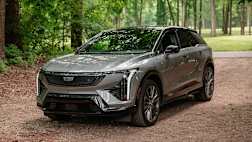Much like the equally revered and reviled mullet haircut - business at the front, party at the back - a hybrid is a combination of two different elements that go together like Vegemite and toast.
When talking cars, a hybrid is the combination of a traditional petrol or diesel-powered internal-combustion engine (ICE) with a battery-powered electric motor (or two) to drive the wheels, creating a middle-point between emissions-causing and emissions-free driving.
These vehicles are often misconstrued and occasionally even advertised as 'self-charging', but be mindful these are very much just that middle-point, and will not charge their electric drivetrains without the intervention of the internal combustion drivetrain at some stage.
The main benefit of a hybrid electric vehicle, in case you haven’t already guessed, is that it isn’t always using the ICE, which pleasingly cuts down both your fuel costs, and the carbon emissions that come out of your car’s tailpipe.

How do so-called 'self-charging' hybrids work?
If you’ve ever wondered “How does a hybrid car work?”, the answer is simple - although first, there are a few different types of hybrids that you need to know about.
How a plug-in hybrid electric vehicle (PHEV) works is right there in the title: it needs to plug in to an external power source, like a wallbox charger or a domestic power socket, to charge its batteries, and is capable of driving in emissions-free EV mode (on average 50-60km, but this number can be higher or lower, depending on the size of the vehicle’s battery).
There’s also what’s known as a “mild hybrid”. These have a starter-generator - an engine starter motor that also acts as an electricity generator - which is able to send energy back into the car’s battery. Although the ICE is constantly running in a mild hybrid, the electrical assistance it receives does help the car’s fuel economy (in a mild sense, of course).

A standard hybrid, often known as a “series-parallel hybrid”, has a smaller battery, and it doesn’t need to plug-in to an external power source. It can typically operate at speeds of up to 40km/h, and distances of 2km, before the ICE kicks in.
The battery in this type of hybrid could be seen as self-charging (see below), which typically happens via a process called “regenerative braking”. This is when kinetic energy is created as a car slows down, and that energy is harnessed and sent either directly to the electric motor that drives the wheels, or to the vehicle’s battery to be stored for future use.
The ICE can also supply supplemental recharging of the battery by acting as a generator while either in motion or idling.
As such, it is misleading to describe these vehicles as 'self-charging' given there is always a need for an internal combustion engine to facilitate charging of the electric drivetrain.
'Self-charging' hybrid cars: pros and cons
Pros
Efficiency
Ever been on the road and noticed another car that seem to turn its engine off while idling at the lights, only to start back up again once it’s time to keep moving? This is because hybrids come with a stop/start function that switches the engine off when coasting slowly or when stopped, saving on fuel costs and cutting down on harmful emissions in the process. (Non-hybrids can also pull off this trick in more modern vehicles.)
.jpg)
No range anxiety
A common worry among drivers considering an electric vehicle (EV) is range anxiety, aka the fear the battery will run out of charge somewhere inconvenient before you’ve had a chance to recharge it. But by having an ICE to back-up the battery-powered electric motor in a hybrid, this has next to no chance of happening, as long as you’ve still got some petrol in the tank, of course (and it’s a lot easier to find a place to fill up with fuel).

Performance
Electric motors produce maximum torque from zero revs, which means you get instant response and power from the throttle. The combination of ICE and electric motor means the petrol tank can be smaller and lighter, which also adds to a hybrid’s overall efficiency.
Cons
Still needs internal combustion
Despite what impression your smug friends may be under, hybrid vehicles aren't the ultimate environmental solution. They are a big step in the right direction, but still require a lot of resources to build, and still emit some carbon and other harmful elements from their tailpipe.
Cost
Hybrids are typically more expensive than equivalent ICE vehicles, but as more models enter the Australian market, prices will invariably drop, and price parity should be reached between hybrids and other EVs in the next few years.
.jpg)
Less space
The battery packs used to power electric motors are on the heavy and large size, and they’re typically stashed in the lower rear of EVs. This can result in less luggage space in the boot, which isn’t an ideal result, especially if you have a family who like to travel as if they’re moving house every time they hop in the car.

Battery degradation
Battery packs in cars are typically guaranteed for around eight years, but the fact remains that they will degrade over time. This means that a battery pack will struggle to hold a charge more and more as the years progress, meaning more reliance on the ICE, which probably goes against why you bought a hybrid in the first place.

A selection of 'self-charging' hybrid cars available in Australia
Toyota RAV4 GX Hybrid
Price: From $36,070, plus on-road costs
Subaru XV Hybrid
Price: From $35,490, plus on-road costs
Hyundai Ioniq Hybrid Elite
Price: From $35,690, plus on-road costs
Kia Niro HEV S
Price: From $39,990, plus on-road costs
Lexus RX450H Luxury Hybrid
Price: From $91,760, plus on-road costs





.jpg)
.jpg)



.jpg)
.jpg)



.jpg)



.jpg)







